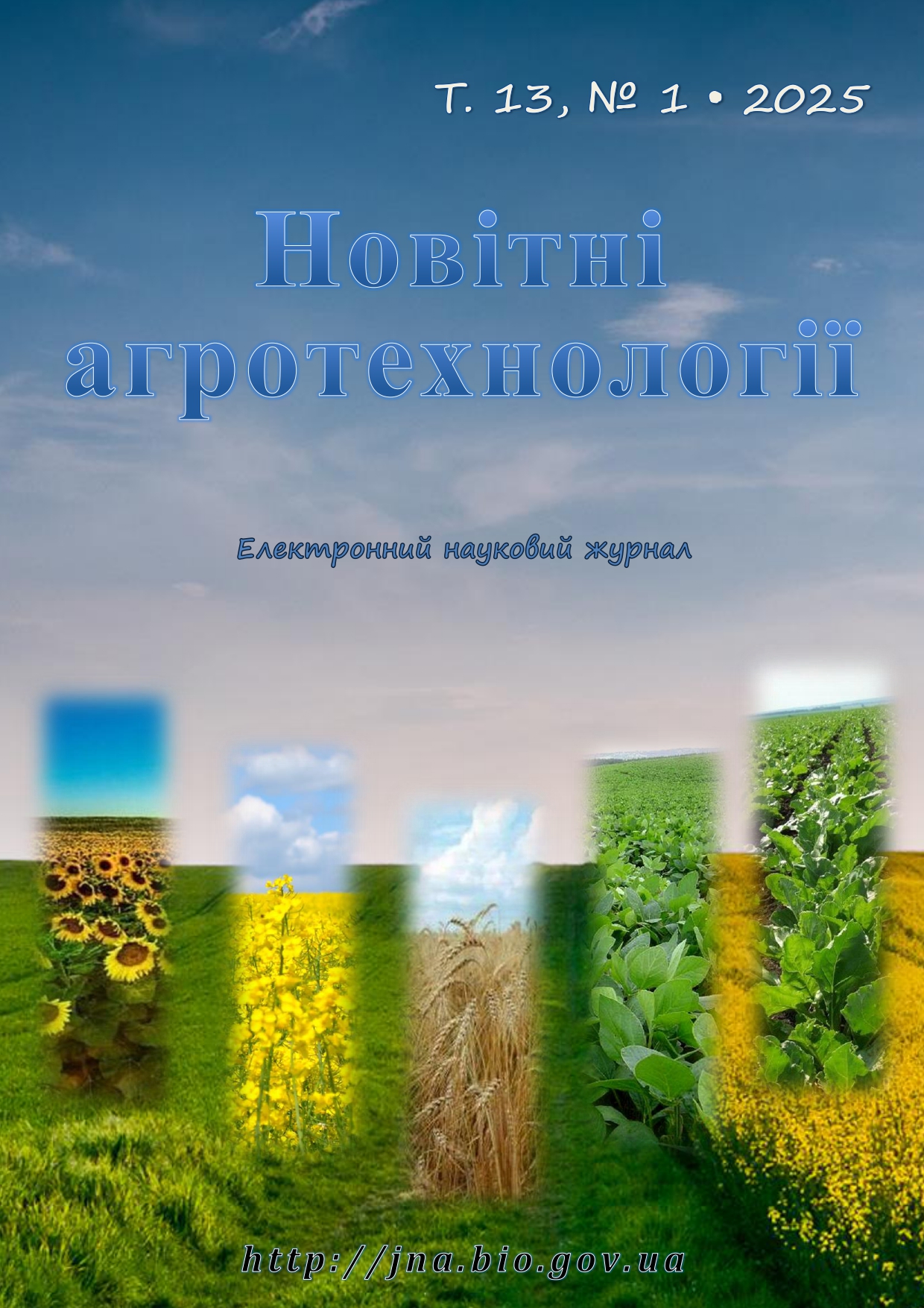Визначення критичних фаз росту й розвитку міскантусу гігантського
DOI:
https://doi.org/10.47414/na.13.1.2025.323001Ключові слова:
ВВСН, шкала Куперман, шкала Задокса, шкала Фікеса, шкала Хауна, шкала Келлер – БагліоніАнотація
Мета. Установити закономірності росту й розвитку міскантусу гігантського та визначити критичні періоди за реакцією на фактори середовища. Методи. Польові дослідження проводили в умовах зони нестійкого зволоження Правобережного Лісостепу України на дослідному полі Інституту біоенергетичних культур і цукрових буряків НААН України (50.023194, 30.173895) упродовж 2020−2024 рр. Результати. Фактори, які можуть спричиняти стрес або загибель рослин міскантусу гігантського, можна умовно розділити за величиною впливу на основні й додаткові (тобто такі, які посилюють стрес, спричинений дією основного фактору), а за ступенем толерантності рослин до них на такі, дія яких може бути знівельована, й ті, впливу яких уникнути неможливо. У цьому дослідженні не враховували фактори глобального впливу на рослини, наприклад, відсутність снігового покриву, адже за зниження температури ґрунту в кореневмісній зоні нижче –15…–20 °С та відсутності снігового покриву загинуть не тільки рослини міскантусу, а й більшість посівів озимих злакових культур. Також не брали до уваги ті фактори, які не призводять до загибелі рослин, наприклад, низька температура повітря рано навесні тільки відтерміновує появу листків над поверхнею ґрунту. А також ті, вплив яких на ростові процеси рослин міскантусу неможливо достовірно оцінити (додаткові фактори стресу). Отже, у результаті опрацювання даних й аналізу факторів впливу на ріст і розвиток міскантусу гігантського можна виділити такі критичні періоди: перший − макростадія 1 (розвиток листків) – весняні заморозки з короткочасним зниженням температури до –2 °С; другий – період активного росту й споживання великої кількості вологи – від макростадії 3 до макростадії 6. Висновки. Під час вирощування міскантусу гігантського найкритичнішими за впливом низьких температур повітря є фенофази за шкалою ВВСН від 00 до 19, а за дефіцитом вологи – від 30 до 69.
Посилання
Greef, J. M., Deuter, M., Jung, C., & Schondelmaier, J. (1997). Genetic diversity of European Miscanthus species revealed by AFLP fingerprinting. Genetic Resources and Crop Evolution, 44, 185–195. https://doi.org/10.1023/A:1008693214629
Haun, J. R. (1973). Visual quantification of wheat development. Agronomy Journal, 65(1), Article 116. https://doi.org/10.2134/agronj1973.00021962006500010035x
Arnoult, S., & Brancourt-Hulmel, M. (2015). A review on Miscanthus biomass production and composition for bioenergy use: Genotypic and environmental variability and implications for breeding. BioEnergy Research, 8(2), 502–526. https://doi.org/10.1007/s12155-014-9524-7
Christian, D. G., Riche, A. B., & Yates, N. E. (2008). Growth, yield and mineral content of Miscanthus × giganteus grown as a biofuel for 14 successive harvests. Industrial Crops and Products, 28(3), 320–327. https://doi.org/10.1016/j.indcrop.2008.02.009
Clifton-Brown, J. C., Breuer, J., & Jones, M. B. (2007). Carbon mitigation by the energy crop, Miscanthus. Global Change Biology, 13(11), 2296–2307. https://doi.org/10.1111/j.1365-2486.2007.01438.x
Heaton, E. A., Dohleman, F. G., & Long, S. P. (2008). Meeting US biofuel goals with less land: The potential of Miscanthus. Global Change Biology, 14(9), 2000–2014. https://doi.org/10.1111/j.1365-2486.2008.01662.x
Cadoux, S., Riche, A. B., Yates, N. E., & Machet, J. M. (2012). Nutrient requirements of Miscanthus × giganteus: Conclusions from a review of published studies. Biomass and Bioenergy, 38, 14–22. https://doi.org/10.1016/j.biombioe.2011.01.015
Dohleman, F. G., Heaton, E. A., Arundale, R. A., & Long, S. P. (2012). Seasonal dynamics of above- and below-ground biomass and nitrogen partitioning in Miscanthus × giganteus and Panicum virgatum across three growing seasons. GCB Bioenergy, 4(5), 534–544. https://doi.org/10.1111/j.1757-1707.2011.01153.x
Sanderson, M. A., West, C. P., Moore, K. J., Stroup, J., & Moravec, J. (1997). Comparison of morphological development indexes for switchgrass and bermudagrass. Crop Science, 37(3), Article 871. https://doi.org/10.2135/cropsci1997.0011183X003700030029x
Jones, M. B., Finnan, J., & Hodkinson, T. R. (2015). Morphological and physiological traits for higher biomass production in perennial rhizomatous grasses grown on marginal land. GCB Bioenergy, 7(2), 375–385. https://doi.org/10.1111/gcbb.12203
Feekes, W. (1941). De tarwe en haar milieu. In Verslagen van de Technische Tarwe Commissie, 17 (pp. 523–888). Hoitsema.
Large, E. C. (1954). Growth stages in cereals: Illustration of the Feekes scale. Plant Pathology, 3(4), 128–129. https://doi.org/10.1111/j.1365-3059.1954.tb00716.x
Moore, K. J., Moser, L. E., Vogel, K. P., Waller, S. S., Johnson, B. E., & Pedersen, J. F. (1991). Describing and quantifying growth stages of perennial forage grasses. Agronomy Journal, 83(6), Article 1073. https://doi.org/10.2134/agronj1991.00021962008300060027x
da Costa, R. M., Lee, S. J., Allison, G. G., Hazen, S. P., Winters, A., & Bosch, M. (2014). Genotype, development and tissue-derived variation of cell-wall properties in the lignocellulosic energy crop Miscanthus. Annals of Botany, 114(6), 1265–1277. https://doi.org/10.1093/aob/mcu054
Hastings, A., Clifton-Brown, J., Wattenbach, M., Mitchell, C. P., & Smith, P. (2009). The development of MISCANFOR, a new Miscanthus crop growth model: Towards more robust yield predictions under different climatic and soil conditions. Global Change Biology Bioenergy, 1(2), 154–170. https://doi.org/10.1111/j.1757-1707.2009.01007.x
Jensen, E., Farrar, K., Thomas-Jones, S., Hastings, A., Donnison, I., & Clifton-Brown, J. (2011). Characterization of flowering time diversity in Miscanthus species. GCB Bioenergy, 3(5), 387–400. https://doi.org/10.1111/j.1757-1707.2011.01097.x
Miguez, F. E., Zhu, X., Humphries, S., Bollero, G. A., & Long, S. P. (2009). A semimechanistic model predicting the growth and production of the bioenergy crop Miscanthus × giganteus: Description, parameterization and validation. GCB Bioenergy, 1(1), 282–296. https://doi.org/10.1111/j.1757-1707.2009.01019.x
Purdy, S. J., Cunniff, J., Maddison, A. L., Jones, L. E., Barraclough, T., Castle, M., Davey, C. L., Jones, C. M., Shield, I., Gallagher, J., Donnison, I., & Clifton-Brown, J. (2015). Seasonal carbohydrate dynamics and climatic regulation of senescence in the perennial grass, Miscanthus. BioEnergy Research, 8(1), 28–41. https://doi.org/10.1007/s12155-014-9500-2
Robson, P., Mos, M., Clifton-Brown, J., & Donnison, I. (2012). Phenotypic variation in senescence in Miscanthus: Towards optimising biomass quality and quantity. BioEnergy Research, 5(1), 95–105. https://doi.org/10.1007/s12155-011-9118-6
Trybula, E. M., Cibin, R., Burks, J. L., Chaubey, I., Brouder, S. M., & Volenec, J. J. (2015). Perennial rhizomatous grasses as bioenergy feedstock in SWAT: Parameter development and model improvement. GCB Bioenergy, 7(6), 1185–1202. https://doi.org/10.1111/gcbb.12210
Zub, H. W., Arnoult, S., Younous, J., Lejeune-Hénaut, I., & Brancourt-Hulmel, M. (2012). The frost tolerance of Miscanthus at the juvenile stage: Differences between clones are influenced by leaf-stage and acclimation. European Journal of Agronomy, 36(1), 32–40. https://doi.org/10.1016/j.eja.2011.08.001
Martínez-Nicolás, J. J., Legua, P., Melgarejo, P., Martínez, R., & Hernández, F. (2016). Phenological growth stages of nashi tree (Pyrus pyrifolia): Codification and description according to the BBCH scale. Annals of Applied Biology, 168(2), 255–263. https://doi.org/10.1111/aab.12261
Meier, U., Bleiholder, H., Buhr, L., Feller, C., Hack, H., Heß, M., Lancashire, P. D., Schnock, U., Stauß, R., Van Den Boom, T., Weber, E., & Zwerger, P. (2009). The BBCH system to coding the phenological growth stages of plants: History and publications. Journal für Kulturpflanzen, 61(2), 41–52. https://doi.org/10.5073/JfK.2009.02.01
Bonnett, G. D. (2013). Developmental stages (Phenology). In A. M. Tronsmo, & H. Fykse (Eds.), Sugarcane: Physiology, Biochemistry, and Functional Biology (pp. 35–53). John Wiley & Sons Ltd. https://doi.org/10.1002/9781118771280.ch3
Dalla Marta, A., Mancini, M., Orlando, F., Natali, F., Capecchi, L., & Orlandini, S. (2014). Sweet sorghum for bioethanol production: Crop responses to different water stress levels. Biomass and Bioenergy, 64, 211–219. https://doi.org/10.1016/j.biombioe.2014.03.033
Lancashire, P. D., Bleiholder, H., Van Den Boom, T., Langelüddeke, P., Stauss, R., Weber, E., & Witzenberger, A. (1991). A uniform decimal code for growth stages of crops and weeds. Annals of Applied Biology, 119(3), 561–601. https://doi.org/10.1111/j.1744-7348.1991.tb04895.x
Archontoulis, S. V., Struik, P. C., Vos, J., & Danalatos, N. G. (2010). Phenological growth stages of Cynara cardunculus: Codification and description according to the BBCH scale. Annals of Applied Biology, 156(2), 253–270. https://doi.org/10.1111/j.1744-7348.2009.00384.x
Zadoks, J. C., Chang, T. T., & Konzak, C. F. (1974). A decimal code for the growth stages of cereals. Weed Research, 14(6), 415–421. https://doi.org/10.1111/j.1365-3180.1974.tb01084.x
Hess, M., Barralis, G., Bleiholder, H., Buhr, L., Eggers, T. H., & Stauss, H. (1997). Use of the extended BBCH-scale – General for the description of the growth stages of mono- and dicotyledonous weed species. Weed Research, 37(6), 433–441. https://doi.org/10.1046/j.1365-3180.1997.d01-70.x
Prysiazhniuk, O. I., Klymovych, N. M., Polunina, O. V., Yevchuk, Ya. V., Tretiakova, S. O., Kononenko, L. M., Voitovska, V. I., & Mykhailovyn, Yu. M. (2021). Methodology and Organization of Scientific Research in Agriculture and Food Technologies. Nilan-LTD. [In Ukrainian]
Ermantraut, E. R., Prysiazhniuk, O. I., & Shevchenko, I. L. (2007). Statistical Analysis of Agronomic Research Data in Statistica 6.0: Methodical Guidelines. PolihrafKonsaltynh. [In Ukrainian]
Boersma, N. N., & Heaton, E. A. (2014). Does propagation method affect yield and survival? The potential of Miscanthus × giganteus in Iowa, USA. Industrial Crops and Products, 57, 43–51. https://doi.org/10.1016/j.indcrop.2014.01.058
Meier, U. (Ed.) (2001). Growth stages of mono- and dicotyledonous plants: BBCH Monograph (pp. 141–147). Open Agrar Repositorium. https://doi.org/10.5073/20180906-074619
##submission.downloads##
Опубліковано
Як цитувати
Номер
Розділ
Ліцензія
Авторське право (c) 2025 О. І. Присяжнюк, Н. О. Кононюк, О. А. Маляренко, В. В. Мусіч, О. М. Гончарук, О. Ю. Половинчук, П. Ю. Волошин, М. О. Черняк

Ця робота ліцензується відповідно до Creative Commons Attribution-ShareAlike 4.0 International License.
"Новітні агротехнології" дотримується авторських прав та дозволів CREATIVE COMMONS для журналів із відкритим доступом.
Автори, які публікуються в цьому журналі, погоджуються з такими умовами:
- автори лишають за собою право на авторство своєї роботи та передають журналу право першої публікації цієї роботи на умовах ліцензії Creative Commons Attribution-ShareAlike 4.0 International License, яка дає змогу іншим особам вільно поширювати опубліковане дослідження з обов'язковим посиланням на авторів оригінальної роботи та першу публікацію роботи в цьому журналі;
- автори мають право укладати самостійні додаткові угоди щодо неексклюзивного розповсюдження роботи такою, якою її було опубліковано цим журналом (наприклад, розміщувати роботу в електронному сховищі установи або публікувати у складі монографії), за умови збереження посилання на першу публікацію роботи в цьому журналі.








